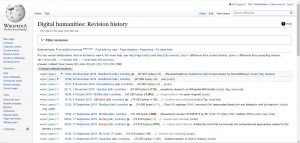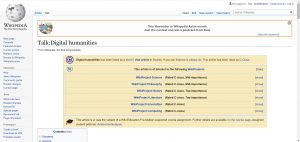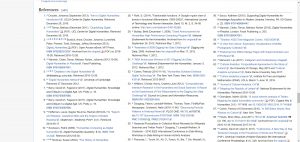
Overview of Posting:
This posting will be centered around the discussion of Wikipedia and its elements as a crowdsourcing tool. Specifically, we will be dissecting when the article was crated, how it was created, and the questions one ought to be asking when using or examining a Wikipedia article. For the purposes of this project we will be using the Wikipedia article on Digital Humanities, found here.
Moreover, this blog post will contain two main sections. The first is a brief discussion as to the structure of the Wikipedia article from the vantage point of a digital humanities professional. Looking at the creation of an debates around this article. Simply, this article will be used as a jumping point to discuss larger issues like crowdsourcing and opensourcing articles. The second section to this posting contains a brief user guide as to how to understand and use Wikipedia sources. I am not talking about how to search for articles, but, more importantly, how to understand an article’s source-base. Meaning, how to understand where to find its citations, and how to use its references in-light of the larger discussion of digital humanities and crowdsourcing.
Part I: Understanding Wikipedia: A General Overview
What questions do you need to ask about how the site was created?
- In order to best understand the evolution of the Wikipedia article, it is best to start with the site’s history: this is found under “Revision History” in the upper-right to the article. Found here. The question that should be answered first is: when was the article created? This helps to produces a timeline of events. If someone is familiar with the field of Digital Humanities (DH), then they have a general understanding as to when the field first emerged; therefore, one can safely guess the creation date of the article.
- The next question is who created the site? These beginning sites generally start when the field becomes more well-known, around 2006 in this case of the DH article. Moreover, these beginning sites are very barren, often only have a title and a general overview of the field or object in question. Then, clicking through the revision history, one can start to see more content added. Now, I know what some of you might be thinking, yes, vandalism on Wikipedia pages does happen, but not as often as one might believe. Roy Rosenzweig in his article “Can History Be Open Source?” states that Wikipedia has a dedicated community of volunteer editors that often fix vandalism, and, therefore, vandalism is much more rare as one would come to believe.
- After one has been able to see the date creation and contributors, one is also able to click on the contributors to see their profiles. This is extremely helpful to see who is contributing to the article, is it the common DH enthusiast or a professional? After a brief review, I can conclude that it is a mixture of both, professionals often add references or citations, while other editors add general article content.
Where should you go within the page to answer those questions?
- There are two locations that are very helpful when reviewing a Wikipedia page:
- The first is the “Revision History” section of the page. A picture of this page can be found below. This page offers a list of all revisions to the page and who made the revisions. This page is also very helpful when trying to understand how this page/article has evolved over time, and what sections of the article has more citations within it.

Screenshot by author, all rights and privileges reserved therein. - The second part of an article that is the references or source section. This can be found at the bottom of the article. What makes this section so important is the fact that the meat-and-potatoes of the article rests within this section. In fact, a large amount of debate goes on behind the scenes as to which articles should be included. This debate takes place on the “Talk” section. It can be found in the upper-left part of the article. Here, contributors are able to talk about the items on the article and it anything needs to be changed. This is one of the most visible ways crowdsourcing is seen, through these inter-dialogue communications between the editors. A picture of this page is below.
- The first is the “Revision History” section of the page. A picture of this page can be found below. This page offers a list of all revisions to the page and who made the revisions. This page is also very helpful when trying to understand how this page/article has evolved over time, and what sections of the article has more citations within it.

How should you use that information when you read and assess the content of an article?
- Therefore, after you have considered all of these questions (curation date, curator, content manipulation and evolution, source addition, and editor commentary) how does this relate to the field of digital humanities? I’m glad you asked. Knowing these answers helps to understand how crowdsourcing works. In the end, crowdsourcing according to Mia Ridge’s article “Crowdsourcing Our Cultural Heritage” (found here) is issuing a general call for public help in either content creation or content correction. Understanding how users interact with the crowdsourced articles helps DH scholars understand, user interaction with the material. In other words, having the general public interact with the article by adding or fixing information allows for an opportunity to improve software and platform creation. Jon Undell in “Heavy Metal Umlaut” talks about crowdsourcing Wikipedia articles and how the larger community greatly contributes to the sources and structure of the article, not just simply fixing content added by project editors.
Part II: Using Wikipedia Sources
This section will be a brief paragraph for users of Wikipedia sources. Below, please find a picture of the first few sources. For this particular article on DH, there are 93 reference citations made. In fact, there was even a discussion by the volunteer editors as to which sources ought to be added. The discussion resulted in a conclusion that all sources ought to be academic or professional, from a reliable source-base.
Simply, this reference list offers a great example as to how crowdsourcing can create a singular place of knowledge. A collection of collections of sorts. One is able to see all of the great citations that have been gathered from many editors adding there input. However, even amongst the editor, like I said earlier, there is a discussion on what ought to count as a citation. David Averbach in his article “Encyclpedia Frown” states that crowdsourcing is an “experiment in controlled anarchy.” While I may think that is a bit extreme, it is clear by the massive source-base of professional and academic sources that this “experiment” is working.

Sources
https://en.wikipedia.org/wiki/Digital_humanities
http://jonudell.net/udell/gems/umlaut/umlaut.html
https://dhcertificate.org/HIST-680/sites/default/files/pdf/Encyclopedia_Frown.pdf
https://dhcertificate.org/HIST-680/sites/default/files/pdf/Can_History_be_Open_Source.pdf